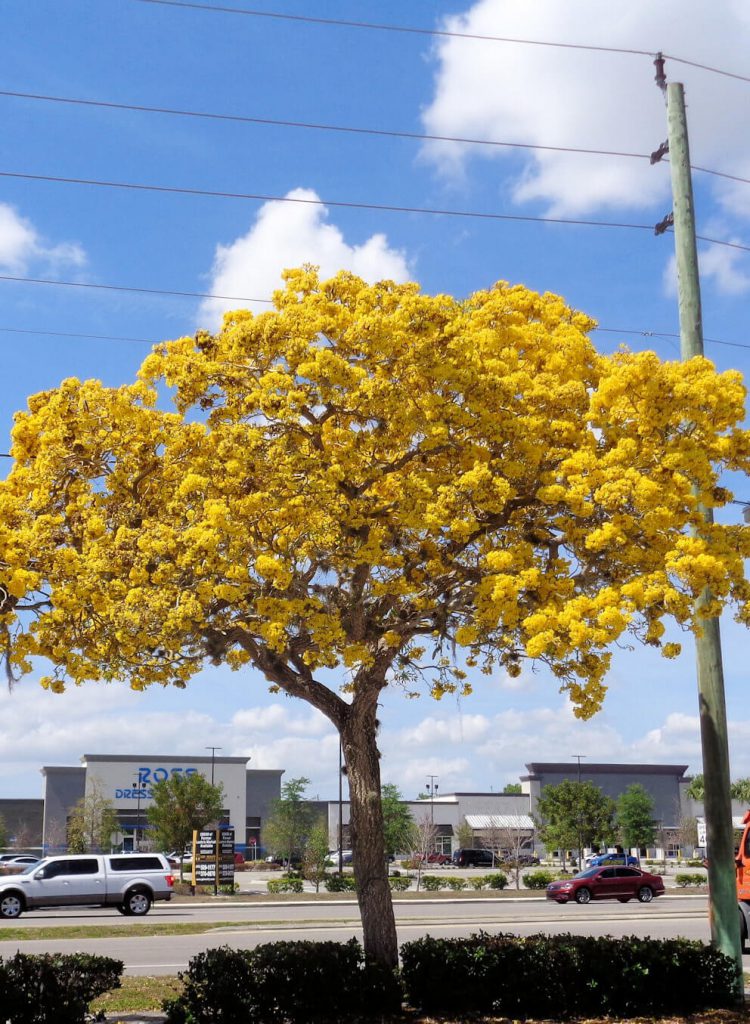
Have you seen the yellow flowering trees in bloom on Cochran Blvd in Port Charlotte? Their relatively short show provides eye-catching beauty that reinforces the appreciation for our subtropical climate! What are these ornamental trees that explode with canary-yellow blossoms at this time? They are one or more species of trumpet tree with names such as the Golden Trumpet tree, the Yellow Trumpet tree, and the Silver Trumpet tree. These trees are small to medium in height and put on quite a show in season.
Trumpet trees are native to tropical America and are valued landscape ornamentals seen throughout South and Central Florida. The identity of these trees can get a bit confusing due to their common names, so let’s stick to Latin for a moment. The genus of these flowering trees has changed, so instead of the well-known Tabebuia, they are now Handroanthus . Handroanthus chrysanthus (sometimes called the golden trumpet tree) is a bit cold tender and better adapted to the warmer parts (and microclimates) of Charlotte County and southward. Handroanthus umbellatus (sometimes called the yellow trumpet tree) is better able to tolerate low winter temperatures here and further north. One last species seen in our area is silver trumpet tree. Noted for silvery foliage, contorted trunk and silvery gnarled bark, Handroanthus caraiba, is a little frost sensitive, so plant it in protected area. The huge yellow blossoms of each type are over three-inches long and about one-inch wide. These flowers are funnel-like in shape and are arranged in clusters for maximum showiness. Trumpet trees are deciduous to semi-deciduous trees in nature making the late winter/early spring flower show a pleasant surprise on an otherwise bare woody plant. The yellow flowers are followed by long seed pods which also have some ornamental interest. The attractive leaves on all of these trees are palmate in shape with multiple leaflets.
Locate trumpet trees in a full sun to part-shade area with well-drained, but moderately moist soil. All the trumpet trees tend to develop brittle wood as they age. As such, wind damage can be an issue. Proper pruning may help train a tree to be more wind-resistant over its lifetime. Use the trumpet tree as a specimen tree in a lawn area where it will best be seen and admired in season.
Trumpet trees are not just on Cochran Blvd, but are found throughout southwest, Florida. Remember the trumpet tree as you plan out your landscape – they are Florida-Friendly Landscaping™ recommended plants and real show-offs! For more information on flowering ornamental trees suitable for our area, or to ask a question, please visit https://www.facebook.com/CharlotteMGLifeline/. Ralph E. Mitchell is the Director/Horticulture Agent for the UF/IFAS Charlotte County Extension Service. He can be reached at 941-764-4344 or ralph.mitchell@charlottecountyfl.gov.
Resources:
Brown, S. H. (2015) Three Yellow Tabebuia Trees of South and Central Florida. The University of Florida Extension Services, IFAS – Lee County.
Gilman, E. F., Watson, D. G., Klein, R. W., Koeser, A. K., Hilbert, D. R. & McLean, D. C. (2018) Tabebuia chrysotricha: Golden Trumpet Tree. The University of Florida Extension Services, IFAS.
Gilman, E. F. & Watson, D. G. (2014) Tabebuia caraiba: Trumpet Tree. The University of Florida Extension Services, IFAS.
The Florida-Friendly Landscaping Guide to Plant Selection & Landscape Design (2010) The University of Florida Extension Services, IFAS.
 1
1

Comments are closed.